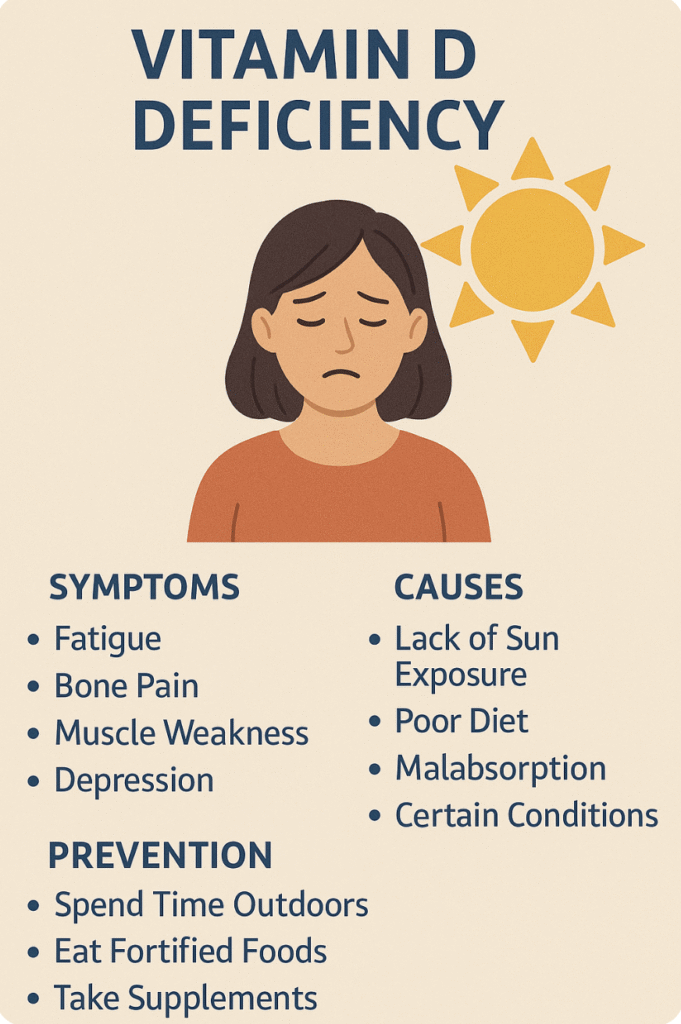Vitamin D, often called the “sunshine vitamin,” is essential for maintaining strong bones, a healthy immune system, and overall well-being. Yet, despite its importance, vitamin D deficiency affects over 1 billion people worldwide, according to global health studies. This widespread deficiency is particularly concerning because it develops quietly, often without clear symptoms until health problems become more severe.
This article explores the science, symptoms, risk factors, and prevention strategies for vitamin D deficiency based on Google Health Content and E-E-A-T guidelines (Experience, Expertise, Authoritativeness, Trustworthiness) to ensure medical accuracy and reliability.
🌤️ What Is Vitamin D Deficiency?
Vitamin D deficiency occurs when the body does not get enough vitamin D to maintain optimal blood levels. The vitamin plays a vital role in calcium absorption, bone mineralization, and immune regulation. Because the human body produces vitamin D through sunlight exposure, limited sun contact or lifestyle changes have made this deficiency increasingly common, even in sunny climates.
⚠️ Common Symptoms of Vitamin D Deficiency
Vitamin D deficiency can present subtly but can lead to major health complications over time. Key symptoms include:
- Chronic Fatigue – Persistent tiredness due to reduced cellular energy function.
- Bone Pain – Aching bones or lower back discomfort linked to weakened bone structure.
- Muscle Weakness – Especially in the legs and hips, affecting balance and mobility.
- Mood Changes – Low vitamin D levels are correlated with depression, anxiety, and seasonal affective disorder (SAD).
- Frequent Illnesses – Vitamin D supports immune defense; deficiency may increase susceptibility to infections.
🩺 Major Causes of Vitamin D Deficiency
- Lack of Sun Exposure
Spending too much time indoors or using excessive sunscreen reduces UVB absorption necessary for vitamin D synthesis. - Poor Diet
Diets low in fatty fish, eggs, or fortified foods lack natural vitamin D sources. - Malabsorption Disorders
Conditions like celiac disease, Crohn’s disease, or chronic liver problems can prevent the body from absorbing vitamin D efficiently. - Certain Health Conditions
Obesity, kidney disease, and older age can reduce vitamin D metabolism or storage.
🍽️ Prevention and Treatment Strategies
1. Spend Time Outdoors
Aim for 10–30 minutes of sunlight exposure at least three times a week, depending on skin tone and climate. Morning or late afternoon sunlight is best for safe UV exposure.
2. Eat Vitamin D-Rich Foods
Include foods such as salmon, mackerel, tuna, egg yolks, mushrooms, and fortified milk or cereal in your diet.
3. Take Supplements
Vitamin D3 (cholecalciferol) is the most effective form for raising and maintaining blood levels. Always consult a healthcare provider before supplementing, especially if you have pre-existing health conditions.
4. Regular Blood Testing
Checking your 25(OH)D levels ensures optimal vitamin D balance. The healthy range is generally 30–100 ng/mL.
💡 Long-Term Benefits of Maintaining Healthy Vitamin D Levels
- Stronger Bones & Teeth – Prevents osteoporosis and fractures.
- Improved Mood & Mental Health – Enhances serotonin production and brain function.
- Enhanced Immunity – Reduces risk of colds, flu, and autoimmune disorders.
- Better Heart Health – Helps regulate blood pressure and inflammation.
🇰🇷 Premium Korean Ginseng Online Shop







